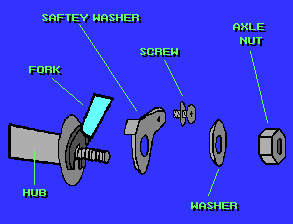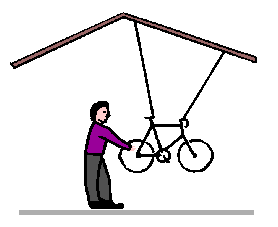Bicycle Glossary A B C D E F G H I J K L M N O P Q R S T U V W X Y Z
Bicycle Glossary - W
![]()
Wald - An American manufacturer of bicycle parts and accessories (such as baskets) most known for inexpensive but heavy steel components.
Washer - A flat metal ring. The primary purpose of washers is to distribute the squeezing force of nuts and bolts over a wider area. For instance, a bicycle wheel mounted with axle nuts but no washers is not secure, even if the axle nuts are tight. Furthermore, trying this without washers may damage the bike's dropouts.
There are variations of washers for special purposes. One of the most common is called a "lockwasher." A lockwasher has a sharp split in it, or several serrations which will help prevent nuts and bolts coming loose due to vibration.

Welding - A technique for fastening metal parts together. The three common types of welding are Gas welding, also known as oxy-acetylene or oxy-propane welding, in which a flame is applied to melt metal together, arc welding, in which an electrical spark is controlled to heat metal sufficiently to melt it, and resistance welding, also known as spot welding, in which an electrical current is passed through two pieces of metal. They melt where they come in contact due to the heat generated by electrical resistance.
Gas welding is not used much in bicycle technology, but the gas welding equipment is frequently used for a form of hot gluing known as "brazing" - which see.
Arc welding in it plain form is also seldom seen in bicycle technology, because it tends to overheat the metal being joined, damaging the properties of alloys, and causing crystallization, which weakens metal. However, variations of arc welding called TIG and MIG are used frequently. Resistance welding is used by manufacturers, but because it is hard to adjust for small or custom productions, is only used by large manufacturers.
Wheel - A complete rotating unit. In the case of bicycles, a wheel consists of at least a tire, inner tube, rimstrip, rim, spokes and hub. Some wheels also have a disk brake or freewheel, coaster brake, etc. Many people mistakenly refer to wheels as "rims" or "tires." The rim is only the metal ring which holds the tire.
Wheel alignment - The condition of the roundness, and lateralness or planeness of a wheel. If the wheel wobbles when it spins, it is laterally out of alignment. If it bounces up and down as it spins, it is out of round or eccentric. Wheels can be aligned by adjusting the lengths of the spokes. That is accomplished by turning the threaded spoke ends, called "nipples" tighter or looser. Synonyms: alignment, true.
How-to: Align or straighten wheels
Wheel builder - A bicycle professional who specializes in building new wheels, generally custom-made ones.
Wheelsmith - A bicycle professional who specializes in wheels, either building new ones, repairing damaged ones, or both.
Wheel truing - To align a wheel.
Wheel truing stand - see truing stand.
Whitworth - A dimensioning standard which was used for many years on bicycles built in the British Empire, but which is very rare now. Standard American (inch or SA), and metric wrenches did not fit Whitworth parts, and bolt threadings were different. Whitworth is based on fifths of an inch. Synonyms: BSW, BS5, British Standard Five.
Work-harden - a condition in which metal that has been bent back and forth many times becomes brittle, and eventually breaks. Work-hardening is often called fatigue.
Workstand or Bicycle Repair Stand- A device for holding bicycles a comfortable height off the ground so they can be easily repaired. Workstands come in two flavors, lightweight portable models, and heavy shop units. The shop ones are usually bolted to the floor.
Workstands have soft jaws which will not usually damage the finish of bicycles as they are clamped by their painted frame tubes. It is always better to clamp a bicycle by its seatpost if possible. If you must clamp it in a work stand by a painted frame tube, do not put the work stand clamp over a decal.
An alternative to workstands is to hang bicycles by padded hooks at the end of cables. The cables should be mounted in the ceiling about six to eight feet apart, and the bike should be suspended by its seat cluster and handlebar stem. Because the attachments at the ceiling are farther apart than the hooks at the bicycle, the front wheel tends to stay straight ahead rather than flopping to one side. Synonym: Repair stand.

![]()
Anything missing or need greater coverage? Let me know - Jeff
Tell a Friend About BikeWebSite
Please feel free to link your web pages to www.bikewebsite.com.
Disclaimer
Although I have attempted to cover the major safety issues, I cannot be responsible for your use of this information. Working on bicycles is dangerous if you do it without considering consequences of bolts left loose, known problems which are ignored, things which should be replaced but are glued instead, and so on. Proceed carefully at your own risk and use common sense. Jeff Napier, and all agents associated with this information, do not offer any guarantee or warranty for your use of this information.
Copyright © 1991-2014, bikewebsite.com